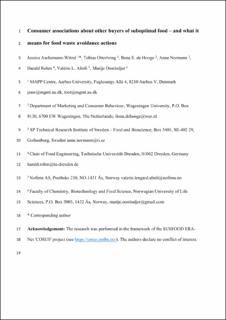| dc.contributor.author | Aschemann-Witzel, Jessica | |
| dc.contributor.author | Otterbring, Tobias | |
| dc.contributor.author | de, Hooge | |
| dc.contributor.author | Normann, Anne | |
| dc.contributor.author | Rohm, Harald | |
| dc.contributor.author | Almli, Valerie Lengard | |
| dc.contributor.author | Oostindjer, Marije | |
| dc.date.accessioned | 2021-01-27T14:34:15Z | |
| dc.date.available | 2021-01-27T14:34:15Z | |
| dc.date.created | 2020-09-14T11:35:53Z | |
| dc.date.issued | 2020 | |
| dc.identifier.citation | Food Quality and Preference. 2020, 80 1-9. | |
| dc.identifier.issn | 0950-3293 | |
| dc.identifier.uri | https://hdl.handle.net/11250/2725035 | |
| dc.description.abstract | One approach to tackling the imminent sustainability problem of food waste is to sell suboptimal food which otherwise might be wasted. However, understanding how the action of buying price-reduced suboptimal food is influenced by the fact that the consumer purchases it publicly while observed by others is yet unexplored. The present research investigates which associations consumers form when they see other consumers purchasing suboptimal foods. In an online experimental survey, consumers of five European countries checked every word that applied (CATA) from a set of items that described what choosing a food item told them about an acquaintance they met in the store in terms of his or her traits. The food item was optimal or suboptimal, fresh or packaged food, and presented with a communication that either underlined a budget saving benefit or a contribution to avoiding food waste. Results show that consumers of suboptimal products are regarded as economic and thrifty, as well as frugal and environmentally concerned. The associations with consumers of optimal products are more diverse, and include both positive and negative wordings, ranging from successful to fussy and inattentive. Consumers’ own level of environmental concerns and value consciousness explain the degree to which they perceive another consumer to have similar traits, revealing that consumers project their own traits on others. Findings imply that stores offering suboptimal food should present and communicate the items in line with the characteristics of the store’s target group, and that suboptimal food choices can trigger positive associations. | |
| dc.language.iso | eng | |
| dc.subject | Suboptimal food | |
| dc.subject | Suboptimal food | |
| dc.subject | Identitet | |
| dc.subject | Identity | |
| dc.subject | Kommunikasjon | |
| dc.subject | Communication | |
| dc.subject | Food Waste | |
| dc.subject | Food Waste | |
| dc.subject | Association | |
| dc.subject | Association | |
| dc.title | Consumer associations about other buyers of suboptimal food – And what it means for food waste avoidance actions | |
| dc.type | Peer reviewed | |
| dc.type | Journal article | |
| dc.description.version | acceptedVersion | |
| dc.source.pagenumber | 1-9 | |
| dc.source.volume | 80 | |
| dc.source.journal | Food Quality and Preference | |
| dc.identifier.doi | 10.1016/j.foodqual.2019.103808 | |
| dc.identifier.cristin | 1829631 | |
| dc.relation.project | Nofima AS: 201702 | |
| dc.relation.project | Norges forskningsråd: 262308 | |
| cristin.ispublished | true | |
| cristin.fulltext | postprint | |
| cristin.qualitycode | 1 | |
